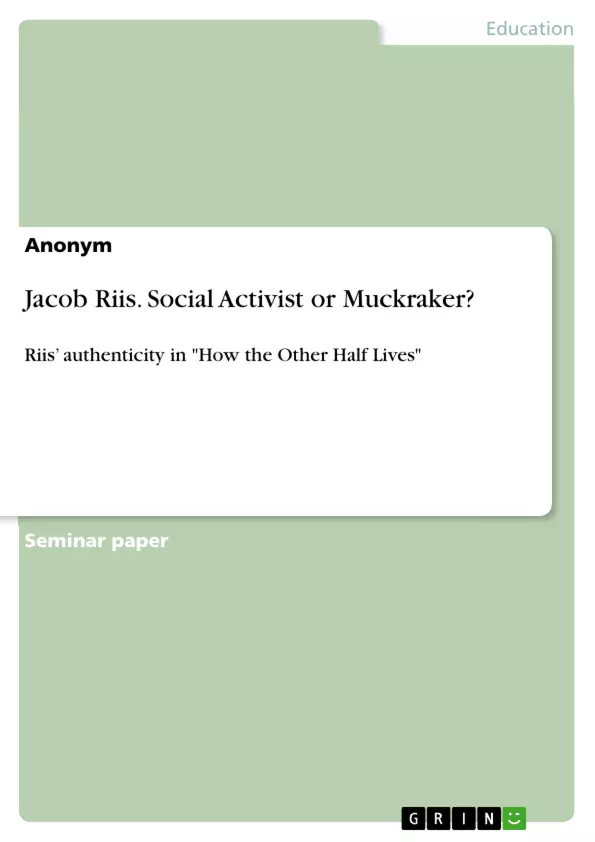In the following paper, the author examines the debate if Riis was a Social Activist, who wanted to enhance the New York slums in the late 19th century, or a Muckraker, who aspired to become famous at any price. The primary source of this debate will be Jacob Riis’ most famous work "How the Other Half Lives". Moreover, this debate will be developed in respect to both Riis’ biography and "How the Other Half Lives"‘content, its structure, its language and its style in general.
Jacob August Riis "How the Other Half Lives - Studies among the Tenements of New York" which was first published in 1890 is an early work of photojournalism. It deals with the tenement and slum conditions in New York in the late 19th century. "How the Other Half Lives" is a documentation and not a fictional story. All 25 chapters report on occurrences which the author has researched and experienced. Jacob Riis uses numerous photographs, sketches and ground plans in each chapter to visualize his words to the reader. Some photographs are recorded by the author himself who makes use of new innovations. Riis’ usage of the flashlight was one of the newest and groundbreaking methods to take pictures at the end of the 19th century. He intensely experimented with flash and refined the work with his camera.
Since Riis put a lot of time, active work and effort in both the photography and the text component, he was regarded as a Social Activist. Riis states that his publication of photojournalism is based on changing and fighting against the social injustice in New York by "providing for every man a clean and comfortable home." In opposition to that, Riis was also regarded as a Muckraker. A Muckraker looks "for information about people’s private lives that they do not wish to make public" (Oxford Dictionary) in order to scandalize. Since he indeed uncovered unknown details of the slums, the lives of the tenants and the power of the landlords, Riis could be labeled as a Muckraker who “scraped up [the covert filth of the society] with the muck-rake” (Roosevelt).
Table of Contents
- Introduction
- Jacob A. Riis between social activism and muckraking journalism
- Social Activist: Riis - a former member of the dwellers
- Muckraker: Riis - the racist
- Social Activist: Racism - only a façade to appeal the wealthy.
- Muckraker: Christianization - Riis' real intention..
- Social Activist: Photojournalism's convincing first steps...
- Muckraker: Phototruth or Photofiction?…………………………..\n
- Social Activist: Riis proving his position - sketches, statistics and numbers.
- Muckraker: No Interviews with the dwellers
- Social Activist: A very vivid description of the slums…......
- Muckraker: Use of exaggeration...
- Social Activist: Riis proposing solutions at the end..
- Conclusion
Objectives and Key Themes
The paper investigates the debate surrounding Jacob A. Riis' role as a social activist or a muckraker in the late 19th century. It examines Riis' most famous work, How the Other Half Lives, analyzing its content, structure, language, and style, and considering Riis' personal biography. The paper aims to determine whether Riis' primary goal was to improve the lives of the poor in New York or to gain fame and notoriety through exposure of the city's underbelly.
- The role of social activism in Riis' work
- The critique of muckraking journalism
- The impact of poverty and homelessness in 19th-century New York
- The use of photojournalism to expose social injustice
- The portrayal of ethnic diversity in the slums
Chapter Summaries
The first three chapters of How the Other Half Lives provide a general overview of tenement housing conditions in late 19th-century New York. Subsequent chapters delve into specific areas and ethnic groups within the slums, highlighting the cramped, unsanitary, and dangerous living conditions of the poor. The text explores the working situations of the poor, emphasizing the hardships they faced.
Keywords
The primary keywords and focus topics of the text include social activism, muckraking journalism, poverty, homelessness, tenement housing, photojournalism, ethnic diversity, social injustice, and the role of the media in social change.
- Quote paper
- Anonym (Author), 2017, Jacob Riis. Social Activist or Muckraker?, Munich, GRIN Verlag, https://www.grin.com/document/537864




